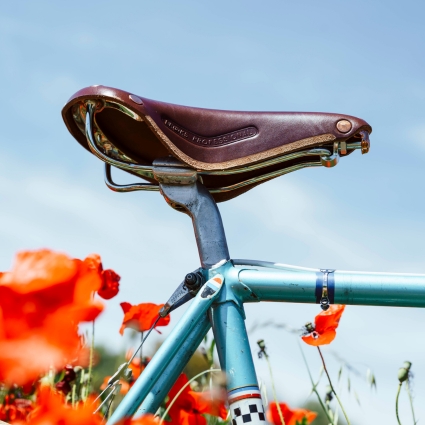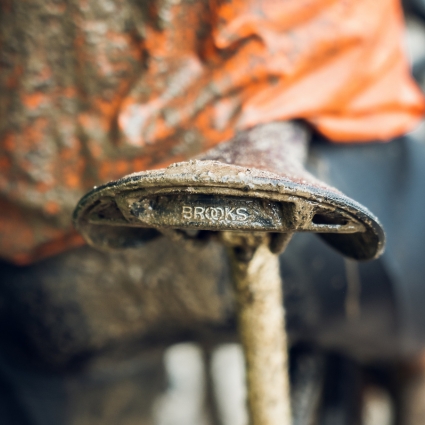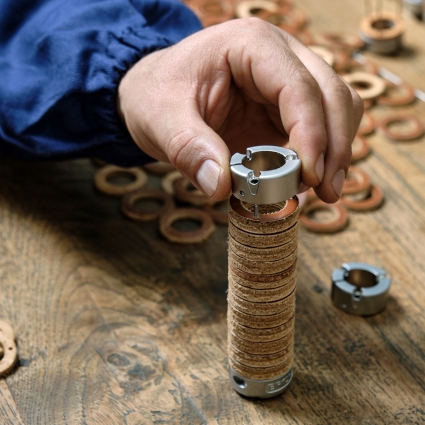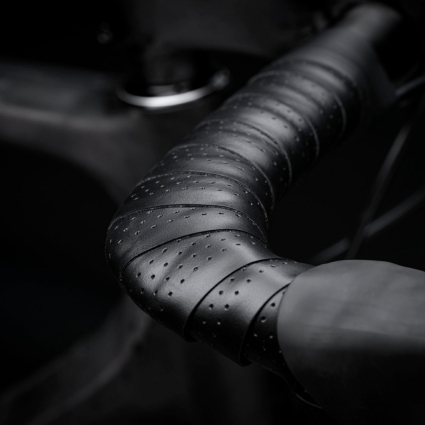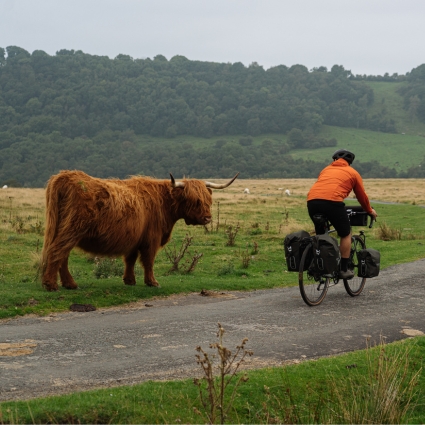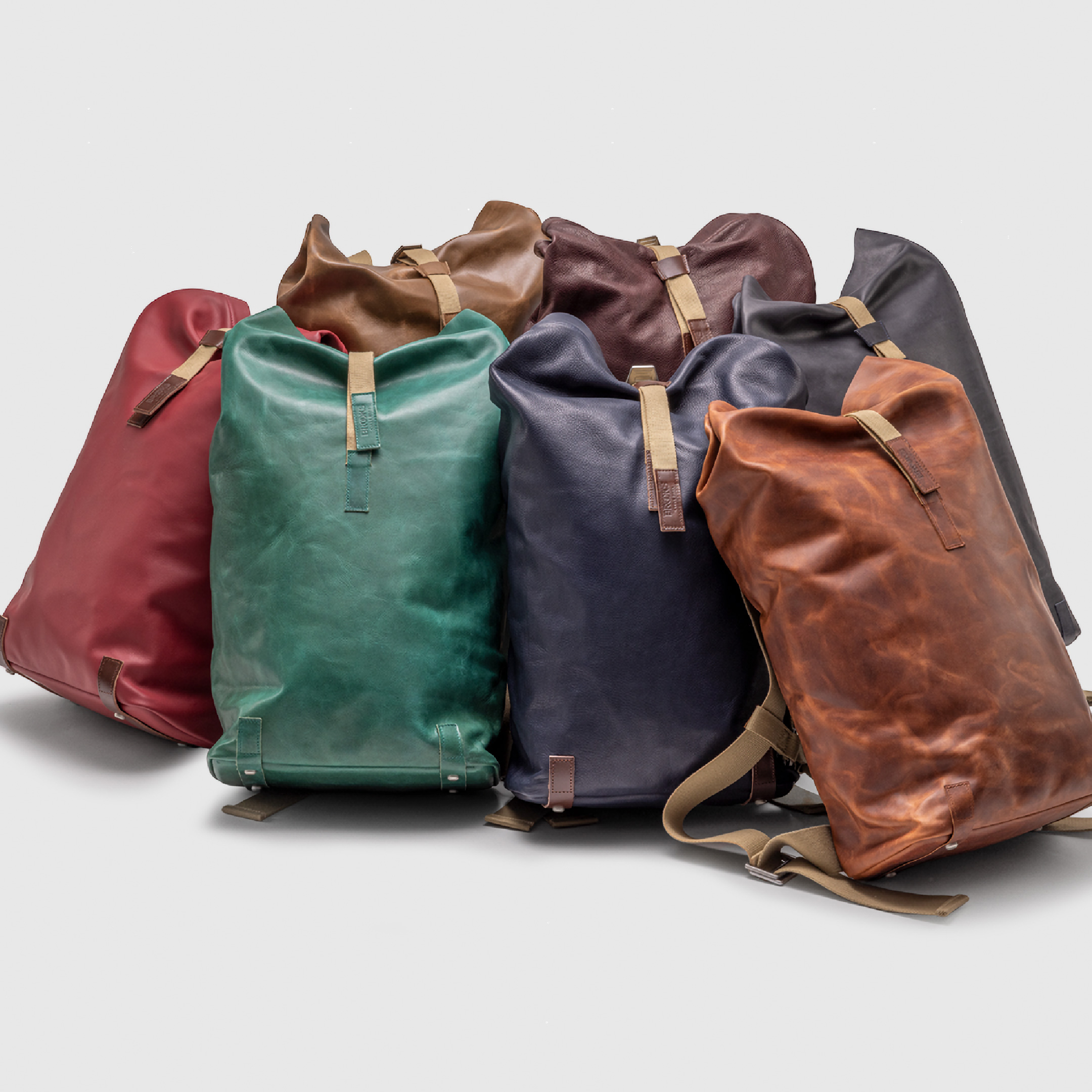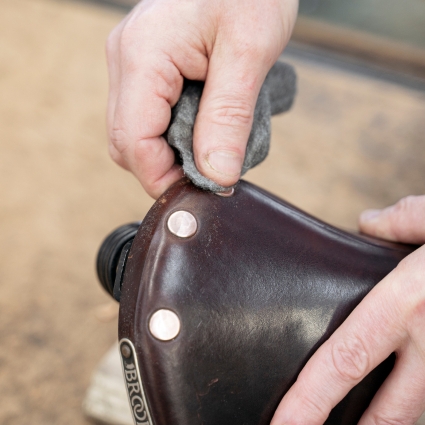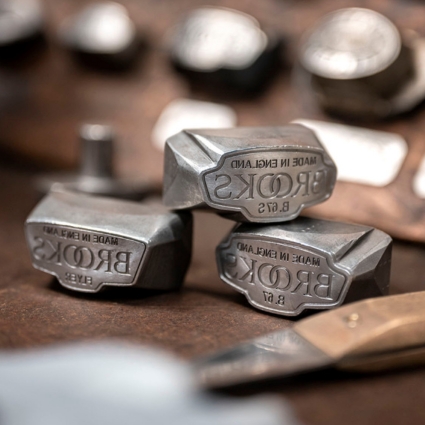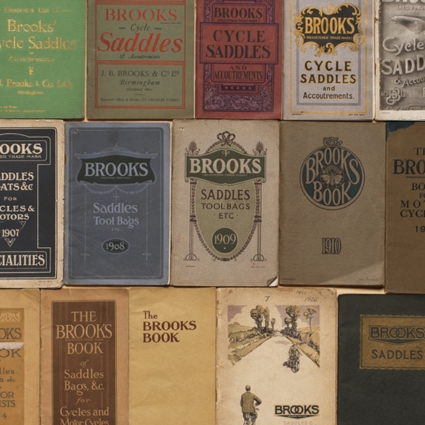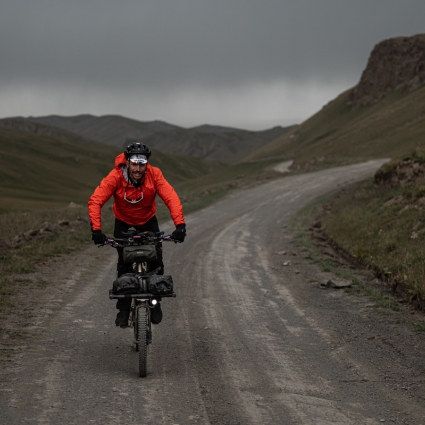
SADDLES
Which is the right Brooks saddle for me?
Our leather saddles come in different shapes and styles depending on what kind of bike or riding position. For example, a wider saddle with springs is ideal for an upright, 90-degree posture. The springs will give you a nice comfy ride, damping the vibrations on the saddle and not feeling bumps on the roads as it soaks up the shocks, otherwise it will travel directly up to the spine. Saddles in this width would be the B67, B66, B33 and others.
Middle widths are often used for touring or commuting when the spinal angle of the rider is in a 45 to 60 degrees position. A middle width will work fine for the times when you want to go fast and low, but if you want a relaxing ride, you can do that too. There’s room for both on these saddles. A typical saddle in this range is our classic, best-selling B17, or its rubber companion, the Cambium C17.
As a general rule, the more athletic the riding position, the narrower the saddle. The narrowest saddles are for riders who lean forward to cheat the wind while sitting more toward the front of the saddle to maximise power transfer to the pedals. During hard efforts, the rider will even be perched directly on the nose! This is, by the way, where we got the saying ‘on the rivet.
Is my saddle compatible with a standard (micro adjust) seat post?
Some of our wider saddles with springs come with an additional clamp and are not compatible with the modern, micro adjust seat post, but instead with an old-style seat pillar. These saddles have a double or triple rail system. For saddles such as these, the clamp is first affixed to the saddle rails and then attached to seat-post. These are more common on older classic bikes.
Most modern bikes however, will have a seat-post with a micro adjustable clamp. For this type of seat post there are many single-railed Brooks options. Brooks saddles with this type of undercarriage are the B17, B67, and Flyer as well as all of the sportier, racing models like the Swift and Swallow. In addition, all Cambium models and single rail and therefore should only be used with a micro adjust seat post.
If you have a double- or triple-rail saddle, but no clamp, the appropriate clamps can be purchased from our website.
Special note: the B67 and the B66 models are the same, but the B67 is has a single rail for a micro adjust seat post and the B66 a double for use with the clamp. Depending on what seat-post you have on your bike, you would choose accordingly.
Why do some Brooks saddles use large, copper rivets while others use small, steel ones?
With copper rivets, the soft metal allows for a larger head, which over time keep the leather from pulling over the rivet and thus increases the saddles longevity. Each broad-headed rivet sits flush against the surface of the leather and therefore must be precisely hammered by hand to prevent any damage to the leather top during manufacture. These rivets may also be re-hammered over time to remain flush with the saddle surface. Steel nickel rivets are used on our more economical options and are machine pressed in the factory. These have the advantage of reduced cost, and are perfectly suitable for many types of use.
Why do some of your saddles have a hole in the saddle top?
This is known as Carved version and it allows for a more flexible that alleviates pressure in the perineum experienced by some cyclists. This cut out also helps to make the saddle break in faster. There are laces on the side to keep the structure in shape and dial in the tension of the saddle, without these the leather flaps will spread out and lose their shape. There is a different width cutout for men (wider) and women (narrower).
How do you know when you’ve reached the “broken in” point?
There is not an exact moment, as leather is a living thing and it will continue to change and evolve through use. However, as a general rule, when the leather is flexible and has two dimples from your sit bones, it is safe to say that it your saddle is “broken in”.
What is the weight limit for your saddles?
Most of our saddles do not have a maximum weight limit due to each rider having a different style of riding as well as environmental considerations. However, if you are 20 stones (280 pounds/127 kg) we do have two heavy duty leather saddles, B33 and B135, and within the Cambium range, C67 is suitable up to 264 pounds/120 kg.
Some saddles, such as the Swallow saddle, because of their structure do not have as much support from the flaps, or “wings”, compared to our other saddles. The Swallow will break in much faster because of this, but if you’re a heavier rider this is not a good option for you. This saddle is recommended only if you are racing and if you don’t ride as often.
Do you make saddles specific for women?
We do offer ‘S’ version on some standard saddles, ’S’ meaning short, because it’s shorter on the nose about an inch or so. This is a traditional solution for women riders, though many women prefer to use a standard Brooks model.
Why do I need to break in my leather saddle?
New leather is tough because of the numerous treatments of the tanning process, as well as the moulding process done at our factory. This leaves the fibres very strong, but also quite rigid. “Breaking in” is the process in which the saddle leather becomes supple and more flexible. Time, effort and care hold the key to bringing your leather saddle to its best condition.
Primarily through riding, the leather will mould to the shape of your anatomy and become more flexible. Over time, the natural movement of the leather will act like a hammock whilst riding. But be careful to make sure that the leather does not sag too low, as this will cause it to contact the metal structure and could lead to saddle failure, not to mention being uncomfortable, as you could be sitting on the upper rails of some models or even the seat post itself.
How long will it take for a leather saddle to break in?
This is always difficult to answer because everyone is different in shape and size and also depending on how far you ride, how often and how long you spend sitting down on the saddle. The weather can also play a big part on this. The answer is never the same. But, the more you ride, the faster it will break in.
How do I care and maintain my Brooks leather saddle?
Whatever the material, Brooks saddles will age beautifully and provide the user with years of uninterrupted use. However, as such, they do require a small amount of common sense looking-after. Our selection of care products are designed to keep your leather saddle looking great and functioning at its best.
As leather is a natural material and each piece reacts differently, we cannot give exact indications, but we recommend that you inspect your saddle every 6 months, depending on your cycling frequency. However, please do not over treat your saddle as this may damage it.
There are two key tasks that are essential to properly and optimally maintain your leather saddle.
Saddle Tension
With time and use, the leather on your saddle will undergo natural stretching, gradually reducing its tension. Without any intervention, the leather will begin to sag and lose its shape, leading to a loss of comfort as well as excess play in the important metal components, risking a shorter saddle lifespan or even frame breakage, or the lifting of rivets from the leather surface.
It is therefore crucial to undertake careful inspections of your saddle every 6 months to look for the signs that the leather has stretched.
Recognise Stretching
- Any obvious, deep sagging of the leather when viewing the saddle from the side
- Any perceivable slackness in the saddle assembly found by pressing down on the leather at the rear with the palm of your hand, flex should not exceed more than 5 or 6 mm
Make an adjustment:
- Work from the front of the saddle
- Use your tensioning spanner
- Make a ¼ or ½ clockwise turn on the tension pin nut (90° or 180°)
- Please watch to ensure that only the nut turns and the pin itself does not
If the nose pin turns when as you turn the bolt, you would need pilers to hold the pin when you turn it. Special note: Do not tension a wet saddle.
With a natural material like leather, there will always be variances in behavior, therefore it is not possible to say exactly how much to adjust the tension. However, it is not a good idea to overlook the tension adjustment procedure, and Brooks will refuse both warranty and extended guarantee claims in cases where this has been overlooked and the leather overtightened.
Leather Condition
Like any leather product, your Brooks leather will dry out and lose suppleness with age. Therefore, you need to rehydrate and re-nourish it from time to time. This is done by applying our Brooks Proofide dressing, which is the only leather treatment you should use on your Brooks saddle.
How to apply Proofide:
- Use a soft cloth
- Apply a thin layer of Proofide to cover the entire upper surface of the leather
- Leave on for a minimum of one hour and allow it to penetrate through the surface
- With a clean, dry and soft cloth, vigorously and thoroughly buff the leather surface until all the remaining Proofide will be removed and a healthy sheen will be returned.
Proofide also acts to soften the leather and, if applied too frequently, there might be risk of over-softening the leather to the point that it will no longer to support the weight of the rider. Because of this, apply Proofide only every 6 months.
A Brooks saddle should not be ridden long during very heavy showers or stored over longer periods in direct sunlight or heat, as this can damage the leather. Never ride the saddle when it is very wet. However, if it does get wet, as long as you let it naturally air dry it will be fine.
Most metals will rust over time, so please keep it out of the elements that can do this or wipe it dry. Likewise the hardware can rust, so please think about where you store your bike. Copper rivets can also discolour over time so you may need to polish them carefully, being careful not to get anything on the leather. Regular use should prevent the need for this.
Learn how to properly maintain your leather saddle by watching our video tutorials here.
Make sure that the leather is nourished and isn’t looking dry
Your leather should appear like how you got it the first time, shiny and looking great. If it doesn’t look like that, then it doesn’t hurt you put on a coat of good old Proofide cream on top and underneath. Let it settle for about 40-60 minutes to let the natural ingredients work their magic. Then polish off the excess cream. Please note you may need to do this more than once to make the leather better again. Check your saddle every now and then, at least every 2-3months.
A Brooks saddle should not be ridden long during very heavy showers or stored over longer periods in direct sunlight or heat, as this can damage the leather. Never ride the saddle when it is very wet. However, if it does get wet, as long as you let it naturally air dry it will be fine.
Most metals will rust over time, so please keep it out of the elements that can do this or wipe it dry. Likewise the hardware can rust, so please think about where you store your bike. Copper rivets can also discolour over time so you may need to polish them carefully, being careful not to get anything on the leather. Regular use should prevent the need for this.
Learn how to properly maintain your leather saddle by watching our video tutorials here.
Do you offer spare parts if something breaks? (tension pin, frame/rails, springs)
If part of your leather saddle does break, you can always get this repaired. Some repairs are easily done if you have the proper tools, but most of the time our professional team has the right tools, skills and the experience and can do this for you.
You can find some replacement parts on our online shop at the link below:
https://www.brooksengland.com/take-care-products/repair-products.html
What do I do if it appears that a copper rivet has lifted up from the saddle surface?
Though Copper rivets are hand hammered by our experts, in the event that your rivet is not flush with your saddle surface, you can repair this by tapping it in place with a metal hammer. Make sure you do this on a solid work table and support the reverse side of the rivet with something small and hard.
Learn how to properly repair your leather saddle by watching our video tutorials here.
What kind of warranty is applied to leather saddles?
Leather saddles are covered by the standard 2 years warranty.
Furthermore, if you register you saddle right after the purchase, you can also benefit from the Forever program, that extends guarantee to 10 years total.
You can register your saddle here.
What is the main difference between B17 and Flyer?
B17
This is our most popular and classic saddle and know as a good all-rounder, great for long distance riding and commuting The width is 175mm, suitable for the 45 to 60-degree riding position. So if your looking for a saddle to be use everyday, long distant city rides. This will be great for you. Comes with steel rivets and black single rail. Available in a number of variations including Special (with hand-hammered rivets and lovely chamfered edges), Carved (with an opening to relieve perineal pressure),Titanium (with titanium rails), Softened (with treated leather for “Comfort from Day One”), and the “S” version, a shorter model preferred by some women cyclists.
Flyer
If you love the shape of the B17 but desire added springs to dampen road shocks, this is the saddle for you. The width is 175mm, suitable for the 45 to 60-degree riding position. A saddle to use everyday, either for long distance rides or city commuting. Available in a number of variations including Special (with hand-hammered rivets), Carved (with an opening to relieve perineal pressure, Softened (with treated leather “Comfort from Day One”) and the “S” version, a shorter model preferred by some women cyclists.
What is the main difference between B66 and B67?
Our popular sprung saddles since their introduction, these models are perfect for city cycling and touring in a more upright riding position from 45 to 60 degrees. The difference between the two models are the rails, the B66 is for the older-style seat pillar with a clamp, the B67 is for modern, micro adjust seatposts. Both saddles feature coil springs to dampen the shocks from the road. With black rails, chrome springs and steel rivets, and well as loop eyelets to attach a saddle bag, Available in 3 three standard colours: black, honey and brown. Also available in an ’S’ version preferred by some women cyclists. Also available in an Softened version with treated leather for “Comfort from Day One”.
What is the main difference between B17 Narrow and Team Pro?
B17 Narrow
Similar to the B17 but it’s narrowed down for an aggressive riding position. This is the narrowest saddle that we make, suitable for riding primarily with the hands in the drop position with a spinal angle of 30 to 40 degrees. This can also used for your daily rides or commutes for riders who prefer a very narrow seat.
Team Pro
Team Pro saddle is narrower than the B17 and at 160mm width is suitable for racing, touring and MTB use with the rider seated with a 30 to 45 degree spinal angle. The Team Pro is furthermore cut from the thickest part of the hide and is therefore our most robust and longest-lasting model. Unlike the other models, the team pro does not feature bag loops for saddle bags. It is available in Special (with chromed rails, hand-hammered copper rivets and chamfered edges) and in “S” version, a shorter model preferred by some women cyclists.
What is the main difference between Swift and Swallow?
Swift
A narrower, 150mm wide saddle for racing or daily rides of short to middle distance in the 30 to 45 degree spinal angle. With a crown-like shape in the middle this will take time to get used to but breaking in the leather will result in a better ride and feel. Featuring bag loop eyelets, hand hammered copper rivets, single chrome rails and chamfered edges. Available only in our three standard leather colours: honey, black and brown.
Swallow
The futuristic-looking Swallow is a design from the 1930’s that is still in service today. Due to the lack of saddle wings for support, this saddle is designed for racing use, not daily riding, and will break in fast and need to be tensioned more often than our other leather saddles. This saddle can be used for racing or daily rides in the 30 to 45 degree riding position.
The standard version comes with chrome rails and machined steel rivets and is available in three standard colours: black, honey and brown.
What are Cambium saddles?
Cambium saddles are made from vulcanised natural rubber for flexible performance when riding, reducing shocks and vibrations and offering the rider improved road feel over traditional foam or gel saddles. This construction of the Cambium mimics the leather saddle construction and therefore offers a similar “hammock” comfort.
Cambium is also maintenance free, meaning you do not need to adjust saddle tension. Likewise, the material we use will not be affected by rain. Cambium saddles are also available in a carved version for riders who seek to reduce pressure on the perineum or desire a more flexible saddle. The Cambium is also available in the Carved version.
How do I care for and maintain my Cambium?
With the cambium range we suggest to check your rivets to see if they are still tight. Over time, due to the vibrations from the road the rivets can loosen, though this is a seldom occurrence. Remember these saddles are hand assembled in the factory, which means all maintenance can be done by hand.
What can I do if my saddle makes a creaking noise?
A creaking noise from your Cambium saddle likely means that the nose rails are rubbing somewhere on the rubber top. This can be alleviated with a small dab of grease. Additionally, a noise can be made where the rails meet the backplate by the little black rubber plug. In this case the saddle could be reassembled and a small amount of grease applied at the contact points.
Learn how to properly repair your Cambium saddle watching our video tutorials here.
Which components on Cambium saddles can be replaced?
Cambium saddles are crafted to handle mixed terrain and inclement weather for years of hard riding. But adventures are unpredictable, and sometimes accidents happen. Simple at-home repairs can help you to get a damaged Cambium back on the roads and trails.
The Cambium saddle components, that can be replaced using proper tools, are: rivets, rails, nosepiece and backplate. These spare parts are available in our online shop: https://www.brooksengland.com/take-care-products/repair-products.html
Learn how to repair your Cambium saddle by watching our video tutorials here.
BAGS AND BACKPACKS
How do I clean my canvas bag?
Brooks cotton canvas bags and backpacks may come in a variety of colours and designs, but luckily, looking after each is easy. Just buy our Bag Care Kit and follow a few simple steps to treat your favourite bag with care.
Learn how to maintain your canvas bag by watching our video tutorial here.
How can I re-wax my canvas bag?
It is a common feature for canvas fabric to show marks and fading colour with everyday use: it is the distinctive trait that allows to make every backpack unique.
Although it is not possible to bring the colour back to life, you can protect it from fading fast. You can use any fabric wax as long as it is just a rub on one.
Learn how to properly maintain your cotton canvas bag by watching our video tutorials here.
How do I maintain my leather bag?
As well as for the saddles, leather on bags and backpacks should be kept supple.
The best advice would be to use products specifically for the cleaning of leather bags. Using Proofide to clean your bag can work as long as result in a very noticeable darkening of the leather.
My Mushroom head fastener is loose, what can I do?
If you are having trouble with a loose fastener, apply Loctite glue, in medium strength, in case you ever want to open it again.
ACCESSORIES
Do I need to maintain my Brooks Leather Grips?
The leather on the grips may get darker over time and not all leather colours will match the saddles colour due to a number of factors. The oils from your hands should keep the grips in good shape, but should you suspect the leather on your grips to be drying out, you may apply Proofide to your grips just as you would with your leather Brooks leather saddle.
I purchased Leather Bar Tape. Are there special considerations for wrapping my handlebar?
Leather Bar Tape has an adhesive back to easily adhere to your bars. When wrapping your handlebar, try not to tension the leather too tightly as this could cause it to rip. Due to the elements, when riding this the bar tape could get darker and could dry out the leather, you can apply a Brooks proofide cream to nourish this. Otherwise it could crack the leather as it dries up. If the rubber bar ends doesn’t fit you can cut it thinner so it can go in.
Cambium Rubber Bar Tape I'm having trouble fitting the plugs in my bar ends, what can I do?
Cut some rubber. Bar ends can be cut thin so make it fit into the handle bars.
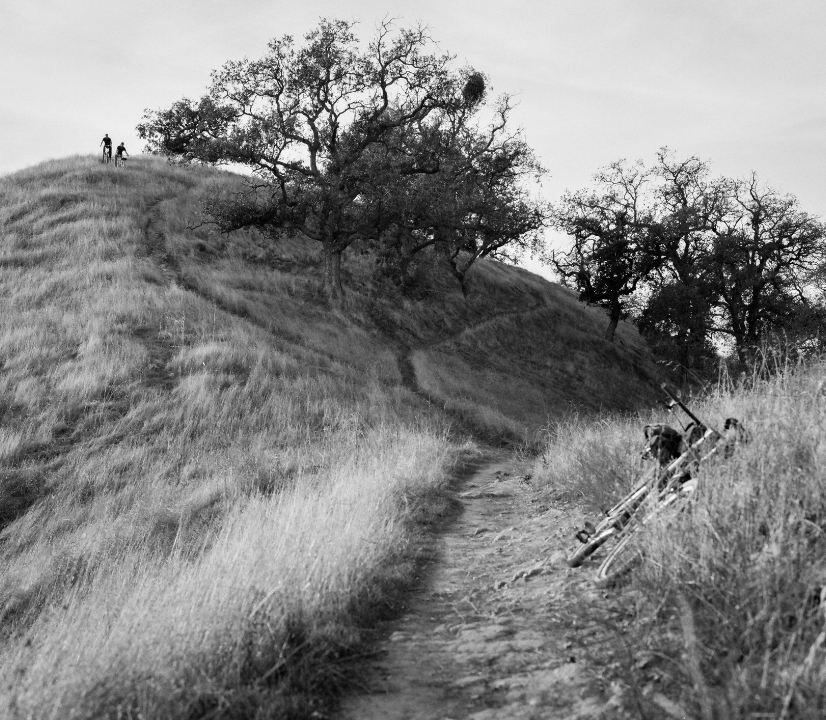
Erhalten Sie 15% Rabatt
auf Ihre erste
Bestellung.
Verpassen Sie keines unserer epischen Abentuer. Melden Sie sich zu unserem inspirierendem Newsletter an.
